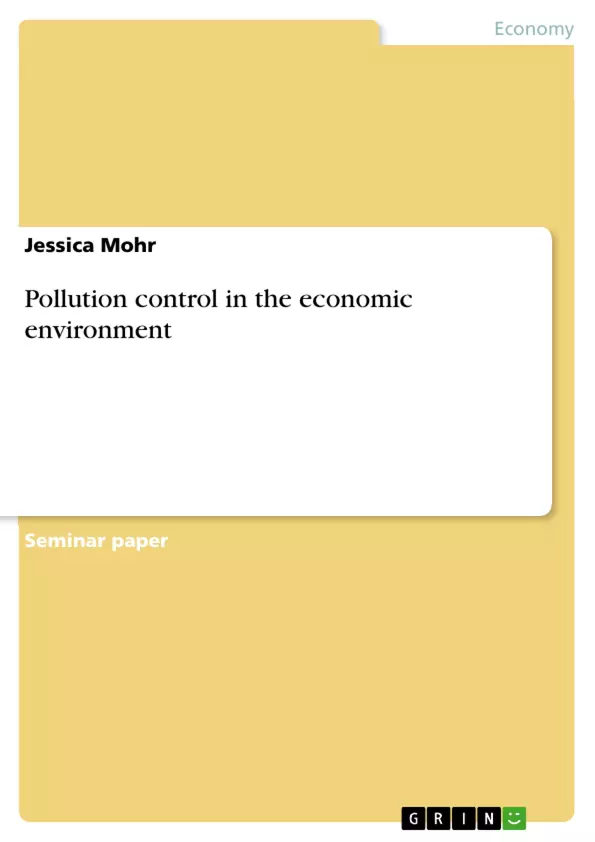Two liability schemes can be used by jurisdictions to ascertain firms comply with environmental protection. Strict liability enforces the companies to use appropriate care. However, the consumers have to be forced to protect themselves, too, by the use of the defence of contributory negligence. Then, the social optimal behaviour of both, the firm and the consumers is reached.
As for negligence, this may induce the firm to take appropriate care. However, as wealth among firms is heterogeneous, this does not necessarily hold for all firms. Additionally, negligence induces con-sumers to purchase too much.
Inhaltsverzeichnis (Table of Contents)
- The basics
- Choice of the liability rule
- The model
- Socially Optimal Locations and Levels of Care
- Strict liability and harmonization
- Negligence and cooperative regulation
- Competition among regulators
Zielsetzung und Themenschwerpunkte (Objectives and Key Themes)
This paper examines the effectiveness of two liability schemes, strict liability and negligence, in achieving socially optimal levels of pollution control. The paper explores the impact of these schemes on firm behavior, consumer behavior, and the overall efficiency of environmental regulation.- The impact of different liability schemes on firm behavior and pollution control
- The role of consumer behavior and the influence of contributory negligence
- The effectiveness of environmental regulation in achieving socially optimal outcomes
- The implications of competition among jurisdictions for environmental standards
- The use of modeling to analyze the strategic interaction between firms, regulators, and consumers
Zusammenfassung der Kapitel (Chapter Summaries)
The basics
This chapter introduces the concepts of strict liability and negligence as they relate to pollution control. It illustrates how these liability schemes can influence the behavior of firms and consumers and their impact on the overall efficiency of environmental regulation.Choice of the liability rule
This section analyzes the effectiveness of both strict liability and negligence in achieving the socially optimal level of care by firms, taking into account the potential for firms to influence the probability of damage through precautionary activities. The analysis highlights the importance of considering the specific context of pollution control and the potential for strategic behavior by firms and regulators.The model
This chapter develops a model of two firms with different risk attitudes operating in multiple jurisdictions. The model analyzes the strategic interaction between firms, regulators, and consumers in setting environmental standards and determining the optimal location for firms.Socially Optimal Locations and Levels of Care
This section examines the objective of regulators to establish optimal levels of care and location patterns for firms, considering the welfare of the social planner. The analysis explores the factors influencing the optimal location of firms, including net benefits and costs associated with pollution control measures.Strict liability and harmonization
This chapter discusses the implications of strict liability for environmental regulation in the context of the European Union. It emphasizes how strict liability can align the incentives of firms with the social optimum by ensuring that firms internalize the full costs of their pollution.Negligence and cooperative regulation
This section analyzes the effectiveness of negligence-based liability and cooperative regulation in achieving socially optimal levels of care and location patterns for firms. The analysis explores the challenges and potential limitations of cooperative regulation in coordinating environmental standards across multiple jurisdictions.Competition among regulators
This chapter investigates the strategic game played by competing jurisdictions in setting environmental standards. The analysis highlights how competition can lead to suboptimal levels of environmental protection as jurisdictions compete to attract firms by lowering standards.Schlüsselwörter (Keywords)
This paper focuses on the key concepts of pollution control, liability schemes (strict liability and negligence), environmental regulation, firm behavior, consumer behavior, social optimum, and the role of regulators in setting standards. The analysis utilizes a modeling approach to explore the strategic interactions between firms, regulators, and consumers.
Final del extracto de 12 páginas
- subir
- Citar trabajo
- Jessica Mohr (Autor), 2009, Pollution control in the economic environment, Múnich, GRIN Verlag, https://www.grin.com/document/127110
Leer eBook



